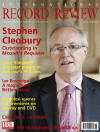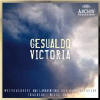Texte paru dans: / Appeared in:
*

International Record Review - (06/2013)
Pour
s'abonner / Subscription information
DG Archiv
4790841

0028947908418 (ID316)
Consultez toutes les évaluations recensées pour ce cd
~~~~ Reach all the evaluations located for this CD
Carlo Gesualdo is being well served by the CD industry in this, the 400th anniversary year of his death. It is doubtful, however, that his music is going to be as beautifully sung or as lusciously presented as it is here by Nigel Short’s outstanding Tenebrae, which seems so thoroughly in its element that it is easy to overlook how perfectly it manages Gesualdo’s complex harmonic twists and turns and the simmering passion which seems to be lurking in the background of every note he wrote. If any choir so perfectly places these anguished intervals and spine-tingling harmonics, reveals such glorious inner balance or preciseness of tuning, or demonstrates such exquisite poise and restraint in dealing with such emotionally charged utterances on disc, again, I would be very, very surprised. If perfection is attainable (which I doubt), we get very close to it here.
Taken from his complete set of Tenebrae Responsoria published in 1611, the disc presents the nine motets designed for performance on Holy Saturday, that most ambiguous day in the church’s calendar when, with Christ languishing in the grave and the Resurrection still to come, the mood is one of overriding desolation. Gesualdo’s is the ideal response, underpinning the dark texts with musical language which is almost romantic in its vivid word setting. In his booklet notes Gabriel Crouch points to a shift from E minor to E flat major in the remarkable ‘Aestimatus sum’ and suggests that it ‘pulls us into the grave and holds us there for all four of the word’s painfully slow syllables’. One might add that Crouch is every bit as good as his word, for he it is, along with his fellow basses, who adds profound depth to this strange music, which is magically illuminated by the arrival of glowing sopranos in the following ‘Sepulto Domino’.
The disc pairs Gesualdo’s music for the Holy Saturday offices with that by Tomás Luis de Victoria. Conventional wisdom has it that Victoria is one of the supreme masters of sacred polyphony in the late sixteenth century while Gesualdo is very much the wild boy. Certainly in Victoria’s three short Lectios, we are firmly in the hands of a true genius, with everything perfectly proportioned and consummately tailored to suit the human voice. There is opulence and warmth in this writing, which unfolds with immensely comforting logic. By comparison, Gesualdo continually takes the breath away with his shocking novelty and unconventionality.
Crouch’s enthusiastic booklet notes attempt — without much conviction, it
has to be said — to suggest that Gesualdo was actually ‘conservative’, more
looking back to an age where church music employed ‘five or six voices in
counterpoint, modal harmony, no accompaniment’ as opposed to the
contemporary trends in which ‘the dramatic burden was placed on individual
singers to convey emotion through the varied powers of the human voice’.
Nobody hearing these divine performances could really swallow that argument,
for while these singers revel in the elegance and logic of Victoria, they
positively glow in the dramatic and arresting idioms of Gesualdo, whose
music, over four centuries on, still has the power to shock and amaze.
Fermer la fenêtre/Close window
Cliquez l'un ou l'autre
bouton pour découvrir bien d'autres critiques de CD
Click either button for many other reviews


